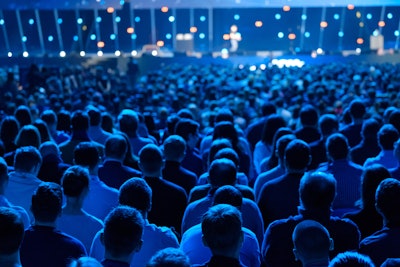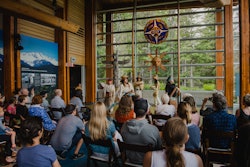
Donald Trump claimed that “tens of thousands” would turn out for his rally over the weekend in Waco, Texas. But photos from the event tell a different story.
“The venue in Waco holds 50,000 people, you can see from this aerial view that the crowd was about, I don’t know, 47,000 short of capacity,” late night host Jimmy Kimmel pointed out during his Monday night monologue. “More people show up to the annual sausage showdown in Waco than showed up to this event.”
Who knew that Kimmel is a bit of a crowd science expert?
In the simplest terms, crowd science studies how people gather and congregate, and how they interact with the environment and themselves, in order to educate organizers about potential consequences or risks and propose implementable solutions.
In recent years, crowd-related tragedies like the ones in Houston and Seoul, South Korea, have brought the need for this kind of study into the public eye. But Marcel Altenburg, a senior lecturer of crowd science at Manchester Metropolitan University in the U.K., said that it needs to be part of the event planning process from the start, as opposed to after a tragedy strikes. He added that the goal of crowd science is to be able to anticipate an incident by detecting the warning signs and knowing how to interpret them in order to solve the problem and prevent an issue from happening.
Altenburg, who has worked with stadium operators for European football clubs and organizers for major city marathons, explained that the next crowd tragedy is much more likely than most people may realize, and that it’s simply luck and timing that often prevents a disaster. And just one trigger, like the Titanic hitting the iceberg, can expose the safety measures that were missed. “But hope alone isn't a good plan,” he said.
While some regularly occurring events allow planners to use past experience to help determine crowd movement, he said other events such as Queen Elizabeth’s death or a sponsored event like the release of a new Nike shoe are harder to predict, making crowd science even more important.
In addition to safety benefits, it can also help cut costs and improve efficiency. “Most of the time, if not always, whenever we crowd optimize an event, the organizer saves money and keeps people safe,” Altenburg said.
For example, Mark Maydon, director at Crowd Connected, a location software company that provides digital tools for event management, pointed out that poor navigation at a trade show impacts attendee satisfaction, resulting in fewer leads because wandering visitors might miss things, including sales meetings. Plus, dissatisfied attendees won’t return to the event next year.
What planners need to consider
When it comes to crowd management, event planners will often provide an overall attendance number, Altenburg said, but that’s not very useful.
“The question is, what kind of demographic do we have?" he posed. "Are we looking at a heavy metal concert? Are we looking at a family event? Something for the older generation? We need to find out a bit more. We need to know our audience.”
He also stressed the need for planners to differentiate from possibly exaggerated press numbers and the real numbers for operational purposes.
Also, planners should consider how attendees will be arriving, Altenburg added. “Will they queue outside before we open the door and 5,000 people will come in at once? Will they arrive over a few hours and do they do that automatically or because they always did it? Or is it something that we're actually planning with arrival times that we have to be staging in a certain way? And what if it rains and then the rain stops? Will that mean that everybody comes at once and are we prepared for something like that?”
At music festivals, for example, he said that organizers need to plan out how they would troubleshoot unexpected events. “It could be a sound problem at a certain stage. Where would those people go and where do I have the space to facilitate them?”
Plus, planners need to keep in mind that because of mobile technology, attendees are able to access all kinds of information about an event (think Snapchat maps), not just what the organizer puts out.
Emma Parkinson, course director of postgraduate programs in Crowded Places and Public Safety Management at Coventry University and a freelance crowd safety management consultant, said that event managers assume that they are “the sole arbiter of information that our audiences have access to…But now so many of our audiences are actually connected in different ways, and that creates different impacts.”
She added that “audiences have access to their own maps and don't need to use ours. It means that they can be busy tracing each other and their friends and taking shortcuts to reach each other rather than using the directions that we give them. It means they are subject to issues such as rumor spreading through crowds or sudden popularity of an artist. And what that means is we need to embed ourselves within that world.” This will help planners look for “different sources of problems than perhaps we might originally have considered,” Parkinson said.
Eric Wielander, vice president of strategy and creative at Eventique, added that when planning a space, “it's essential to consider not only how many attendees are coming through your experience, but how many options you're offering them, what is the scale of those experiences, and how many attendees can engage simultaneously.”
For a recent beauty event in which small packs of influencers were moving through the space, Wielander said that Eventique built a photo moment that allowed guests to take their time getting the perfect shot without feeling rushed. That’s because there were other elements to explore within the activation to distract waiting attendees.
Altenburg recommends that event planners make crowd management a priority before it’s too late, saying that clients “call us when they are already on fire…It's only when [they] realize that this will cost us money, insurance, reputation—that's when a crowd expert is brought in.”
Parkinson echoed that sentiment, saying that “all too often major mistakes are made at the design stage of events” regarding features like capacity, ticketing, routing—”decisions that all have substantial financial impact.”



















